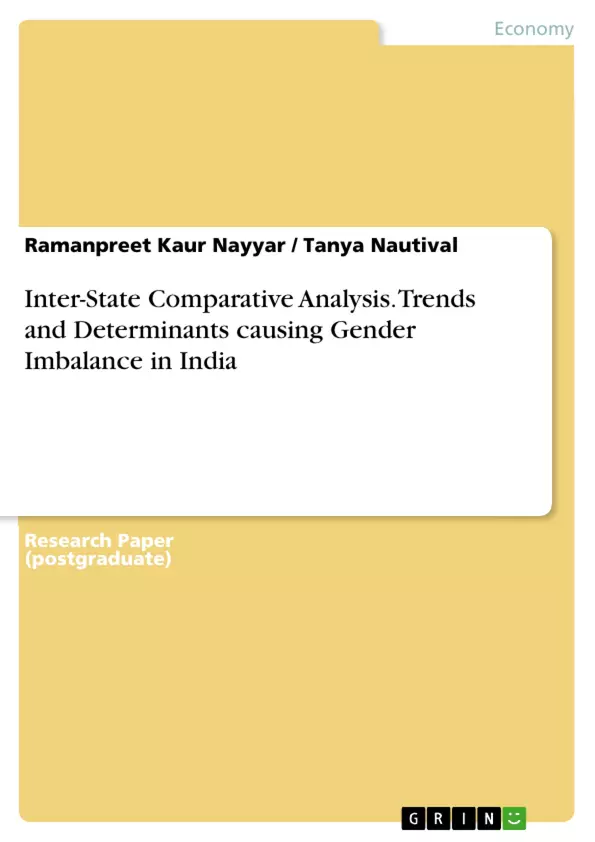Evidences show that many states in our country have shown wide variations in the gender balance. Throughout its long history, India experiences wide variety of cultures and traditions. However, it is unfortunate that this transitional phase led to creation of a culture where women are treated inferior to men. Also, it has been seen that the ideology and perception further differs on the basis of geographical areas too. On one hand, in a matriarchal society under southern parts, women are treated as leaders and natural heirs whereas on the other hand in northern parts they are not even allowed to born. It is also noticed that states differ in sex ratio on the basis of literacy as well. In this context, the present study aims to analyze the trends and their determinants of the skewed distribution among the states and the union territories of the country.
Inhaltsverzeichnis (Table of Contents)
- Abstract
- Introduction
- Literature Review
- Objectives of the Study
- Research Methodology
- Data Source & Definition of Variables
- Selection of Major States
- Results and Discussion
- Conclusion
- References
Zielsetzung und Themenschwerpunkte (Objectives and Key Themes)
This research aims to investigate and analyze the gender imbalance in India by examining trends and determinants of the skewed sex ratio across different states and union territories. The study seeks to understand the factors contributing to this disparity and explore possible solutions to address the issue.
- Trends in Gender Imbalance Across Indian States
- Determinants of Gender Imbalance, Including Socioeconomic Factors and Cultural Norms
- The Impact of Literacy Rate and Population Density on Gender Imbalance
- The Role of Government Policies and Interventions in Addressing Gender Imbalance
- The Importance of Changing Social Attitudes and Mindsets Towards Gender Equality
Zusammenfassung der Kapitel (Chapter Summaries)
- Abstract: This chapter provides a concise overview of the research, highlighting the widespread variations in gender balance across India and the need to understand the underlying causes. It emphasizes the detrimental societal consequences of gender imbalance, particularly the prevalence of female feticide and the resulting demographic disparities.
- Introduction: This chapter sets the stage for the research by discussing the alarmingly low sex ratio in India, highlighting the country's position among the ten most populated nations. It underscores the historical and cultural context of gender inequality, emphasizing the historical subjugation of women and the persistence of patriarchal societal structures. The chapter also explores the consequences of the declining sex ratio, emphasizing the social and demographic imbalances, as well as the rise in crimes against women.
- Literature Review: This chapter provides a critical analysis of existing research on gender imbalance in India, focusing on past studies examining the economic value of women, the impact of agricultural practices on gender roles, and the practice of female feticide. It highlights the role of various factors, such as socioeconomic pressures, cultural norms, and the availability of technology, in contributing to the gender imbalance.
- Objectives of the Study: This chapter outlines the specific research objectives, aiming to compare sex ratio trends across BIMARU states, document the trends in union territories, analyze the child sex ratio, and investigate the correlation between literacy rate and sex ratio, as well as between population density and sex ratio.
- Research Methodology: This chapter describes the research methodology employed, including the data sources used, definitions of variables, and the selection of major states for analysis.
Schlüsselwörter (Keywords)
The key terms and concepts explored in this study include: gender, sex ratio, women, child, feticide, socioeconomic factors, cultural norms, literacy rate, population density, government policies, societal attitudes, and gender equality. This research aims to understand the multifaceted issue of gender imbalance in India by examining the interplay of these key elements.
- Citar trabajo
- Ramanpreet Kaur Nayyar (Autor), Tanya Nautival (Autor), 2017, Inter-State Comparative Analysis. Trends and Determinants causing Gender Imbalance in India, Múnich, GRIN Verlag, https://www.grin.com/document/377780



